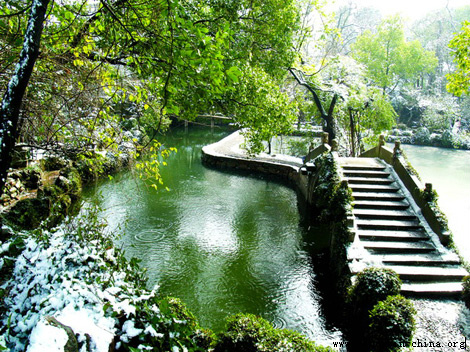| Home > Living In China |
Color History in China
For more than 2000 years, the Chinese people have used brilliant colors. Today in modern China, red is a very popular color. However, contrary to popular belief, ancient peoples did not pay special attention to the color red.
Traditional Chinese physics taught that the five elements are water, fire, wood, metal and earth, in that order. They correspond to black, red, blue-green, white and yellow, respectively. Ancient Chinese people believed that the five elements made everything in nature. Five thousand years ago during the reign of Huang Di (known as the Yellow Emperor) people actually worshiped the color yellow. From that period forward, through the Shang, Tang, Zhou and Qin dynasties, China's emperors used the Theory of the Five Elements to select colors. Because people understood that "colors come naturally while black and white are first," they gradually established a relationship between colors and the principle of the five elements, which guided the natural movement of heaven and the heavenly Tao. People chose clothing, food, transportation and housing according to natural changes in the seasons--from spring to summer and autumn, and then to winter. Traditional Chinese views regard black, red, blue-green, white and yellow as standard colors
The I-Ching, or Book of Changes, regards black as Heaven's color. The saying "heaven and earth of mysterious black" was rooted in the observation that the northern sky was black for a long time. White represented gold and symbolized brightness, purity, and fulfillment. White also is the color of mourning.
The Chinese people, both ancient and modern, cherish the color red. Red is everywhere during Chinese New Year and other holidays and family gatherings for it symbolizes good fortune and joy. Unfortunately, since the Communist takeover of China, red has been used by the Chinese Communist Party to represent danger, blood, violence and radical actions.
Blue-green indicates spring when everything overflows with vigor and vitality. Yellow symbolizes the earth. The old saying, "Yellow generates Yin and Yang," meant that yellow is the center of everything. Color embodies an even richer culture in Chinese folk traditions. Yellow is the color for emperors. Yellow often decorates royal palaces, altars and temples. Yellow also represents being free from worldly cares. Therefore it is also a color respected in Buddhism. Chinese culture created a close and binding relationship between color and ceramics, murals, paintings, and poetry...even city planning. Many of the silk goods unearthed from ancient tombs have maintained their original colors of brown, red, black, purple, and yellow. Chinese pottery and lacquer ware uses rich color even more extensively. The formulation of richly coloreFor more than 2000 years, the Chinese people have used brilliant colors. Today in modern China, red is a very popular color. However, contrary to popular belief, ancient peoples did not pay special attention to the color red.
Traditional Chinese physics taught that the five elements are water, fire, wood, metal and earth, in that order. They correspond to black, red, blue-green, white and yellow, respectively. Ancient Chinese people believed that the five elements made everything in nature. Five thousand years ago during the reign of Huang Di (known as the Yellow Emperor) people actually worshiped the color yellow. From that period forward, through the Shang, Tang, Zhou and Qin dynasties, China's emperors used the Theory of the Five Elements to select colors. Because people understood that "colors come naturally while black and white are first," they gradually established a relationship between colors and the principle of the five elements, which guided the natural movement of heaven and the heavenly Tao. People chose clothing, food, transportation and housing according to natural changes in the seasons--from spring to summer and autumn, and then to winter. Traditional Chinese views regard black, red, blue-green, white and yellow as standard colors
The I-Ching, or Book of Changes, regards black as Heaven's color. The saying "heaven and earth of mysterious black" was rooted in the observation that the northern sky was black for a long time. White represented gold and symbolized brightness, purity, and fulfillment. White also is the color of mourning.
The Chinese people, both ancient and modern, cherish the color red. Red is everywhere during Chinese New Year and other holidays and family gatherings for it symbolizes good fortune and joy. Unfortunately, since the Communist takeover of China, red has been used by the Chinese Communist Party to represent danger, blood, violence and radical actions.
Blue-green indicates spring when everything overflows with vigor and vitality. Yellow symbolizes the earth. The old saying, "Yellow generates Yin and Yang," meant that yellow is the center of everything. Color embodies an even richer culture in Chinese folk traditions. Yellow is the color for emperors. Yellow often decorates royal palaces, altars and temples. Yellow also represents being free from worldly cares. Therefore it is also a color respected in Buddhism. Chinese culture created a close and binding relationship between color and ceramics, murals, paintings, and poetry...even city planning. Many of the silk goods unearthed from ancient tombs have maintained their original colors of brown, red, black, purple, and yellow. Chinese pottery and lacquer ware uses rich color even more extensively. The formulation of richly colored glazes infuses these pieces with a brilliant and lustrous appearance. For ancient Chinese people, color feeds the spirit and expresses the depth of human experience.
d glazes infuses these pieces with a brilliant and lustrous appearance. For ancient Chinese people, color feeds the spirit and expresses the depth of human experience.
Custom
 more
moreWeb Dictionary
Primary&secondary
Beijing National Day School
Beijing Concord College of Sino-Canada
Brief Introduction of BCCSC Established in the year 1993, Huijia School is a K-12 boarding priva...Beijing Huijia Private School





 print
print  email
email  Favorite
Favorite  Transtlate
Transtlate 







